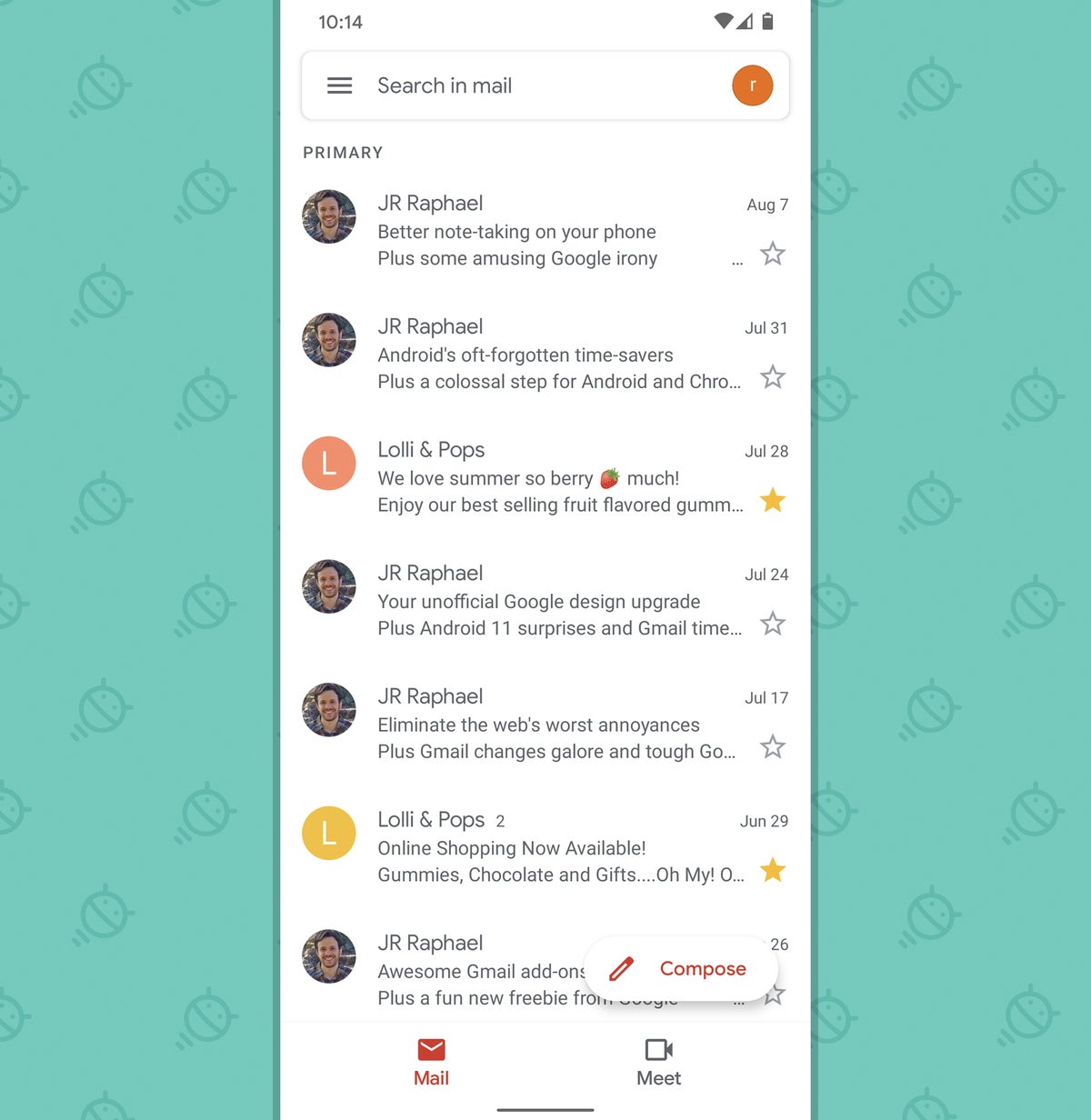If you use Gmail from your Android phone, brace yourself: You're in for an obnoxious surprise.
There's a chance you've already gotten it, in fact — and if you haven't, rest assured: You will soon. The surprise is the arrival of a new on-screen menu that lives in your inbox and takes up a fair portion of the vertical scrolling space there. Its sole purpose? Why, putting a prominent link to Google Meet in your face at all times, of course.
Yes, really — an entire screen-width toolbar that's plastered onto your inbox simply to hold two oversized options: Mail and Meet. Like so much of what we've experienced in this exhausting year, it almost feels more like satire than reality, like something someone on the internet would've come up with as a joke ("Hey, didja see how Google's gonna try to force us all to use Meet next?! LOL!~").
Unfortunately, though, this change is all too real.
 JR
JR Now, there's good news here, if you haven't yet realized it: You can opt out of that monstrosity and reclaim the space in your mobile inbox. (Open up the Gmail app's settings, tap the name of your account, then scroll down 'til you see the "Show the Meet tab for video calling" option and uncheck the box alongside it.) But that's almost beside the point. The real issue here is how unabashedly Google is shoving its videoconferencing service down our throats — and how eerily familiar that effort feels.
Let me set the stage here and see if you sense the same parallel I do: Google is trying to make its way into an area where there's already a dominant, de-facto-standard player — a player whose name is basically synonymous with the medium, to the point where it's frequently used as a common noun or verb. Google desperately wants to catch up and claim its place in that market, despite the other player's dominance. And so it's aggressively working to push its service anywhere it can, regardless of the effect that has on its other apps.
Little by little, you'll see signs of the new service showing up in some unnecessary-seeming and irksome areas — with gigantic buttons in places you don't need 'em, on-by-default integrations in services where you weren't expecting 'em, and gigantic on-screen interfaces in apps where you absolutely don't want 'em. Even if you can turn many of those things off, most people won't realize that's possible — and the onus will fall upon you, as the user, to actively seek out such options and play this game of ongoing virtual whack-a-mole.
I just described what's happening with Google Meet right now. I also just described exactly what happened with Google+ seven years ago.
The all-too-spot-on parallel of those two service rollouts should be very, very worrisome for anyone at Google.
You remember the whole Google+ rollout debacle, right? Google desperately wanted to compete with Facebook and convince people to use its shiny new social networking service — so what'd it do? It put Google+ everywhere. You couldn't avoid it: Practically anywhere you looked in Google apps and services, you'd see some manner of over-the-top G+ integration.
And what happened? Google irritated most of its user base by pushing G+ down their throats at every possible turn — and, well, we all know how things ended up in the long run. It was a damn shame, too, because Google+ was actually a fantastic service for those of us who took the time to get to know it. But most people, understandably, were almost preemptively annoyed by its very existence. Few put in the effort to find the right communities within the service's virtual walls. And really, who can blame 'em?
Google's Meet push hasn't quite reached G+ levels of aggressiveness yet, but once you see the general similarity of its trajectory, it's impossible to unsee the similarities.
At its beginning, Google+ was described as an "urgent effort involving almost all of the company’s products" — and a blatant response to the realization that Facebook was rapidly expanding its own online hub where Google services weren't especially relevant. It was, by most counts, a hurried and frantic effort and one in which Google was very much on the defense, responding to what someone else was doing. And it was an effort in which the main advantage and plan for success seemed to revolve mostly around tapping into Google's existing services and relying on those to push people into the new arena.
But, surprise surprise, people generally didn't appreciate the aggressive intrusion of Google+ into so many other Google services (and, uh, that's putting it mildly). And yet, what are we seeing happen with Google Meet — a product whose sudden aggressive expansion and move away from being a limited-purpose, enterprise-specific tool seems pretty clearly designed to respond to the surging popularity of Zoom in mainstream culture?
Well, we've got that lovely over-the-top Meet tab in the Gmail mobile app, of course. But beyond that, Meet has greeted unsuspecting users with a plus-sized presence in Google Calendar, on both the mobile and desktop fronts — including a little-noticed option within Calendar's settings to "automatically add Google Meet video conferences" to every event you create by default. That means every time you invite someone to an event from Calendar, they're probably receiving a link to "join with Google Meet," regardless of whether Meet actually has anything to do with the event or not.
 JR
JR That's to say nothing of the in-your-face pop-ups that have been appearing across Google apps to promote Meet's newfound presence, again on both desktop and mobile.
 JR
JR The most frustrating thing about this is that simply making Meet available in certain logical places wouldn't be such a big deal — and probably wouldn't rub anyone the wrong way. With the Gmail mobile app, for instance, Meet would seem perfectly appropriate as an option within the app's main menu, where the far-more-closely-aligned Calendar and Contacts services reside. Heck, it'd even make sense within the three-dot menu icon that's present whenever you're viewing an individual message — y'know, the same place where you can find an option to add an email into Google Tasks.
Launching a Meet-related function while viewing your email is foundationally no different than launching a Tasks-related function while viewing your email. So why does one go into the overflow menu, where it arguably belongs, while the other gets put into a space-killing on-screen menu bar — a menu bar that's almost comically empty, since it exists only to draw your attention to that one option?
The reason is painfully obvious: because Google is desperate to promote the latter service and get people in the habit of using it, no matter the cost or the effect on user experience in other places.
Meet, like G+, is a fine enough service and is almost certainly something some users — particularly those already invested in the Google ecosystem — would be happy to use. But force-feeding it to everyone is the wrong way to increase its adoption. And it's hard to imagine anyone finding something like that new Gmail menu bar to be desirable, let alone useful.
You'd think Google, of all companies, would have learned this lesson by now. But, well, here we go — again.
Sign up for my weekly newsletter to get more practical tips, personal recommendations, and plain-English perspective on the news that matters.

[Android Intelligence videos at Computerworld]



























































































